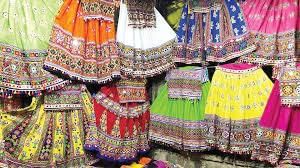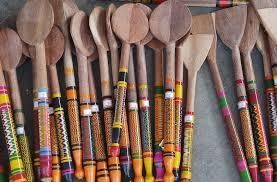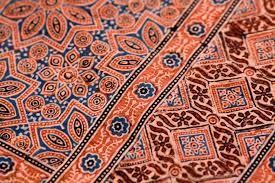Handicrafts of Gujarat | Gujarat State PSC (GPSC) Preparation: All subjects - GPSC (Gujarat) PDF Download
Handicrafts of Gujarat
Gujarat is renowned for its diverse handicrafts that showcase the rich cultural heritage of the state.
Let's delve into two prominent forms of traditional artistry:
Beadwork
- Beadwork, a traditional craft of Gujarat, involves the meticulous joining of beads to create a variety of items.
- Commonly known as Moti Bharat, this craft is centered in Gujarat and is popular for making decorative household items like chaklas, Indhonis, Mangalkalash & nariyal, as well as intricate jewelry such as necklaces and earrings.
- Artisans from regions like Saurashtra, Rajkot, Bhavnagar, Amreli, and Junagadh specialize in bead craft, with techniques passed down through generations.
- Tribal communities in districts like Panchmahal, Vadodara, and Dahod also contribute to this craft, creating stunning three-dimensional forms by incorporating beads into their work.
Patola
- Patola is an exquisite silk saree crafted using a unique double ikat technique, originating from Gujarat.
- These sarees are revered for their intricate tie-dye patterns that are visible on both sides of the fabric, a hallmark of the Salvi community's skilled craftsmanship.
- Distinct patterns characterize Patola sarees, with four primary designs that are intricately woven by artisans in Gujarat.
Woodwork

- Woodwork in Gujarat showcases a rich tradition, ranging from small handicrafts to intricate furniture pieces.
- In regions like Surat, Kutchh, and Saurashtra, one can find exceptional examples of traditional woodwork.
- Notable styles include Minakari furniture from Rajkot and Sankheda furniture, known for their quality craftsmanship.
- Gujarat offers a variety of hand-carved exotic wood furniture in diverse styles.
- Artisans use techniques like inlay work with colored wood, horns, and even modern materials like plastic in creating artifacts and wooden plaques.
Zari Work
Zari, an intricate thread traditionally made of gold or silver, is a prominent feature in Indian, Pakistani, and Persian garments as well as home decor items like curtains.
- Artisans weave Zari into fabrics like silk, felt, or velvet to produce elaborate patterns.
- The thread is a key element in Zardozi embroidery, a renowned Indian embroidery style used in clothing and decor.
- India produces four main types of Zari: real, semi-real, imitation, and plastic.
- Real Zari, crafted from silver with gold plating, is reserved for high-end products.
- Semi-real Zari comprises copper coated with silver and gold plating, while imitation Zari is made of copper with silver plating.
- Plastic Zari, made from metallic yarn, is a more affordable alternative.
Hand Block Printing in Gujarat

Hand block printing is a revered art form in Gujarat, known for its intricate designs and vibrant colors. The region boasts a rich tradition of block printing, with various patterns inspired by nature and cultural motifs.
Famous Types of Hand Block Prints:
- Ajarakh Printing: Hailing from Dhamadka and Ajarakhpur in Kutch, this style features intricate geometric patterns.
- Matani-Pachedi or Kalamkari: Known for its narrative storytelling designs, this style is unique to Gujarat.
- Vegetable Prints: Crafted in Dessa, Ahmedabad, and Kutch, these prints utilize natural dyes for a distinctive look.
- Batik Prints: Originating from Bhujpur, Mundra, and Mandvi villages in Kutch, these prints showcase wax-resist dyeing techniques.
- Saudagiri Prints: A specialty of Ahmedabad, these prints feature traditional motifs and colors.
Hand block prints can be found in various cities in Gujarat, including Kutch, Ahmedabad, and Jamnagar.
Embroidery Work in Gujarat
- Aari Embroidery: Aari embroidery, performed with silk threads using a hook, is a renowned craft from Kutch, Gujarat. This intricate embroidery often features motifs like dancing peacocks and human figures in dynamic postures.
- Gujarat's Embroidery Heritage: Gujarat is celebrated globally for its diverse range of embroideries, traditionally crafted by rural communities, particularly women. The state's embroideries are known for their seamless color transitions. Key styles include:
- Ari and Soof: Originating from Banaskantha, characterized by intricate patterns.
- Kathipa, Mahajan, Kanbi, and Rabari: Found in Jamnagar, Bhavnagar, Rajkot, and Junagadh regions of Saurashtra, each with unique designs and techniques.
- Banni or Heer Bharat, Ahir, Mutwa, Soof, Neran, Kharek, and Kutch or Aribharat: Distinct styles from Kutch, known for their elaborate and vibrant patterns.
In Gujarat, women use these embroideries not only to adorn their cholis and ghaghras but also to create decorative household items such as chaklas (rolling boards), wall hangings, torans (door hangings), pillow covers, and cushion covers.
Clay and Terracotta Work in Gujarat
- Clay and terracotta art in Gujarat is rich and diverse. Figures and toys made from clay are significant in Indian pottery. The Dangi tribes of Gujarat have a tradition of crafting clay gods.
- Clay figures depicting animals like horses, cows, bulls, and buffaloes are emblematic of Gujarati art. Modern mud work also thrives in Gujarat.
Leather Work in Gujarat
- Leather craft in Gujarat is exquisite and unique. Tourists should not miss the opportunity to explore and purchase leather products in the region.
- Items such as mirror frames, batwas, mojdis, cushion covers, bags, and purses are skillfully crafted from leather.
- These products often feature embellishments like embroidery, tassels, and mirror work. The Meghwal community is known for their craftsmanship in leatherwork.
Applique and Patchwork in Gujarat
- Applique and patchwork are traditional art forms in Gujarat. Applique involves creating patterns by assembling different fabric patches, adding vibrancy and charm to the final product.
- This technique is used in creating quilts, wall hangings, household items, and clothing. Patchwork, on the other hand, involves using scrap and waste materials to craft items like quilts, awnings, and camel saddle covers. Bharwad women are known for their skill in patchwork.
Tangaliya Work
- Tangaliya is a unique handwoven textile craft specific to the Surendranagar region of Gujarat. It involves intricate patterns used in creating shawls, dupattas, dress materials, and various home decor and accessories.
- The craft holds cultural significance and is a testament to the craftsmanship of the artisans in the region.
Dhurries Work
- In the villages of Kutch, dhurries, carpets, blankets, and rugs are still crafted using traditional pit looms. Artisans weave these items by hand on foot-pedal-operated machines, creating intricate designs with contrasting color schemes.
- The dhurries produced are made from wool, goat hair, and cotton. Handloom weaving remains a significant occupation in these villages, particularly along the Ahmedabad-Bhavnagar highway.
FAQs on Handicrafts of Gujarat - Gujarat State PSC (GPSC) Preparation: All subjects - GPSC (Gujarat)
| 1. What are some famous handicrafts of Gujarat? |  |
| 2. Where can one purchase authentic Gujarat handicrafts? |  |
| 3. What is the significance of Bandhani in Gujarat's handicrafts? |  |
| 4. How is Kutch embroidery different from other types of embroidery in India? |  |
| 5. How can one support the local artisans of Gujarat who create these handicrafts? |  |
















